Entry Database : PDB / ID : 6ejlTitle Structure of 14-3-3 zeta in complex with ASK1 14-3-3 binding motif 14-3-3 protein zeta/delta Mitogen-activated protein kinase kinase kinase 5 Keywords / / / Function / homology Function Domain/homology Component
/ / / / / / / / / / / / / / / / / / / / / / / / / / / / / / / / / / / / / / / / / / / / / / / / / / / / / / / / / / / / / / / / / / / / / / / / / / / / / / / / / / / / / / / / / / / / / / / / / / / / / / / / / / / / / / / / / / / / / / / / / / / / / / / / / / / / / / / / / / / / / / / / / / Biological species Homo sapiens (human)Method / / Resolution : 2.382 Å Authors Petrvalska, O. / Lentini Santo, D. / Obsilova, V. / Obsil, T. Funding support Organization Grant number Country European Commission 675179 - TASPPI - H2020-MSCA-ITN-2015
Journal : To Be Published Title : Crystal structure of 14-3-3 zeta in complex with ASK1 14-3-3 binding motifAuthors : Petrvalska, O. / Lentini Santo, D. / Obsilova, V. / Obsil, T. History Deposition Sep 21, 2017 Deposition site / Processing site Revision 1.0 Nov 8, 2017 Provider / Type Revision 1.1 Mar 7, 2018 Group / Category / Item Revision 1.2 Nov 6, 2019 Group / Category / Item Revision 1.3 Jan 17, 2024 Group / Database references / Refinement descriptionCategory chem_comp_atom / chem_comp_bond ... chem_comp_atom / chem_comp_bond / database_2 / pdbx_initial_refinement_model Item / _database_2.pdbx_database_accessionRevision 1.4 Nov 13, 2024 Group / Category / pdbx_modification_feature
Show all Show less
 Yorodumi
Yorodumi Open data
Open data Basic information
Basic information Components
Components Keywords
Keywords Function and homology information
Function and homology information Homo sapiens (human)
Homo sapiens (human) X-RAY DIFFRACTION /
X-RAY DIFFRACTION /  MOLECULAR REPLACEMENT / Resolution: 2.382 Å
MOLECULAR REPLACEMENT / Resolution: 2.382 Å  Authors
Authors Czech Republic, 1items
Czech Republic, 1items  Citation
Citation Journal: To Be Published
Journal: To Be Published Structure visualization
Structure visualization Molmil
Molmil Jmol/JSmol
Jmol/JSmol Downloads & links
Downloads & links Download
Download 6ejl.cif.gz
6ejl.cif.gz PDBx/mmCIF format
PDBx/mmCIF format pdb6ejl.ent.gz
pdb6ejl.ent.gz PDB format
PDB format 6ejl.json.gz
6ejl.json.gz PDBx/mmJSON format
PDBx/mmJSON format Other downloads
Other downloads 6ejl_validation.pdf.gz
6ejl_validation.pdf.gz wwPDB validaton report
wwPDB validaton report 6ejl_full_validation.pdf.gz
6ejl_full_validation.pdf.gz 6ejl_validation.xml.gz
6ejl_validation.xml.gz 6ejl_validation.cif.gz
6ejl_validation.cif.gz https://data.pdbj.org/pub/pdb/validation_reports/ej/6ejl
https://data.pdbj.org/pub/pdb/validation_reports/ej/6ejl ftp://data.pdbj.org/pub/pdb/validation_reports/ej/6ejl
ftp://data.pdbj.org/pub/pdb/validation_reports/ej/6ejl
 Links
Links Assembly
Assembly
 Components
Components Homo sapiens (human) / Gene: YWHAZ / Production host:
Homo sapiens (human) / Gene: YWHAZ / Production host: 
 Homo sapiens (human)
Homo sapiens (human) X-RAY DIFFRACTION / Number of used crystals: 1
X-RAY DIFFRACTION / Number of used crystals: 1  Sample preparation
Sample preparation Processing
Processing MOLECULAR REPLACEMENT
MOLECULAR REPLACEMENT Movie
Movie Controller
Controller


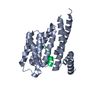
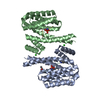
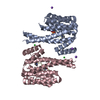
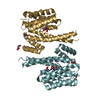



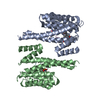

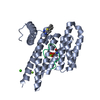
 PDBj
PDBj









